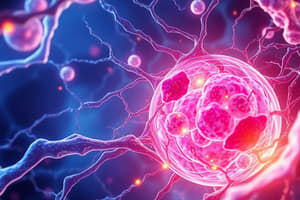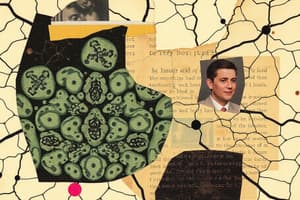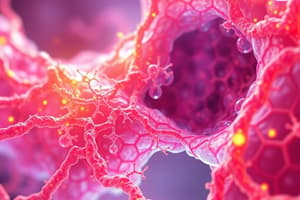Podcast
Questions and Answers
Which of the following is NOT a function of connective tissue?
Which of the following is NOT a function of connective tissue?
- Binding tissues together
- Cushioning
- Cellular respiration (correct)
- Metabolism and energy storage
What component of the extracellular matrix primarily gives connective tissue its hydrophilic properties?
What component of the extracellular matrix primarily gives connective tissue its hydrophilic properties?
- Proteoglycans (correct)
- Elastic fibres
- Glycoproteins
- Collagen fibres
What type of cell is primarily responsible for the production and maintenance of the extracellular matrix in non-specialized connective tissue?
What type of cell is primarily responsible for the production and maintenance of the extracellular matrix in non-specialized connective tissue?
- Adipocytes
- Chondrocytes
- Myofibroblasts
- Fibroblasts (correct)
Which of the following cells are involved in the immune function of connective tissues?
Which of the following cells are involved in the immune function of connective tissues?
Elastin is secreted as a precursor called what?
Elastin is secreted as a precursor called what?
In which type of connective tissue would you find chondroblasts?
In which type of connective tissue would you find chondroblasts?
What characteristic of glycosaminoglycans (GAGs) contributes to the strength of the extracellular matrix?
What characteristic of glycosaminoglycans (GAGs) contributes to the strength of the extracellular matrix?
Which of the following statements about fibrocytes is true?
Which of the following statements about fibrocytes is true?
Which type of collagen is primarily found in tendons and ligaments?
Which type of collagen is primarily found in tendons and ligaments?
What is a characteristic feature of loose connective tissue?
What is a characteristic feature of loose connective tissue?
Which type of collagen is associated with the basement membrane?
Which type of collagen is associated with the basement membrane?
What is a disadvantage of dense regular connective tissue?
What is a disadvantage of dense regular connective tissue?
Which condition is caused by mutations in Type I collagen?
Which condition is caused by mutations in Type I collagen?
What is the main function of brown adipose tissue?
What is the main function of brown adipose tissue?
Which type of connective tissue is characterized by a high proportion of fibers organized in random arrangements?
Which type of connective tissue is characterized by a high proportion of fibers organized in random arrangements?
What is the structure of collagen type 1?
What is the structure of collagen type 1?
Which genetic syndrome is characterized by fragile, extra elastic skin and hypermobility of joints?
Which genetic syndrome is characterized by fragile, extra elastic skin and hypermobility of joints?
In which tissue is collagen type 2 primarily found?
In which tissue is collagen type 2 primarily found?
Flashcards
Connective tissue
Connective tissue
A diverse and abundant supporting tissue that provides structural support, tensile strength, binding, immune defense, metabolism, cushioning, and elasticity.
Fibroblast
Fibroblast
The main cell type in non-specialized connective tissue, responsible for producing and maintaining the extracellular matrix and ground substance.
Ground substance
Ground substance
The clear, viscous substance that fills the space between cells in the extracellular matrix, composed of water, glycosaminoglycans, and proteoglycans.
Glycosaminoglycans (GAGs)
Glycosaminoglycans (GAGs)
A type of polysaccharide found in the ground substance that attracts water and contributes to the negative charge of the matrix.
Signup and view all the flashcards
Fibers in connective tissue
Fibers in connective tissue
Fibers embedded in the ground substance of connective tissue, providing strength and flexibility.
Signup and view all the flashcards
Elastin fibers
Elastin fibers
A type of protein fiber that allows tissues to stretch and return to their original shape.
Signup and view all the flashcards
Collagen fibers
Collagen fibers
A type of protein fiber that provides strength and rigidity to connective tissue.
Signup and view all the flashcards
Wandering Connective tissue cells
Wandering Connective tissue cells
Wandering cells with immune functions, including plasma cells (produce antibodies), neutrophils (phagocytosis), eosinophils (defense against parasites), lymphocytes (immune response), and mast cells (inflammatory reactions).
Signup and view all the flashcards
Collagen
Collagen
The most abundant protein in the body, collagen is a fibrous protein with high tensile strength, providing support and structure to various tissues.
Signup and view all the flashcards
Type I Collagen
Type I Collagen
Type I collagen is the most abundant type, found in bones, skin, tendons, and ligaments, providing strength and flexibility to these tissues.
Signup and view all the flashcards
Type II Collagen
Type II Collagen
Type II collagen is found in cartilage, providing support and cushioning to joints.
Signup and view all the flashcards
Type III Collagen
Type III Collagen
Type III collagen forms reticular fibers, delicate yet strong frameworks for organs, glands, and blood vessels.
Signup and view all the flashcards
Type IV Collagen
Type IV Collagen
Type IV collagen is found in the basement membrane, a thin layer separating epithelial cells from underlying connective tissue.
Signup and view all the flashcards
Loose Connective Tissue
Loose Connective Tissue
Loose connective tissue, characterized by a large amount of ground substance and loosely arranged fibers, binds structures and allows for diffusion. Examples: lamina propria.
Signup and view all the flashcards
Dense Irregular Connective Tissue
Dense Irregular Connective Tissue
Dense irregular connective tissue, characterized by a dense network of randomly arranged fibers, resists force from multiple directions. Example: Dermis.
Signup and view all the flashcards
Dense Regular Connective Tissue
Dense Regular Connective Tissue
Dense regular connective tissue, characterized by a dense network of parallel fibers, resists force in one direction. Example: Tendons and ligaments.
Signup and view all the flashcards
White Adipose Tissue
White Adipose Tissue
White adipose tissue, characterized by large lipid droplets, stores energy and provides insulation. Found in adults, appears empty in sections due to lipid extraction.
Signup and view all the flashcards
Brown Adipose Tissue
Brown Adipose Tissue
Brown adipose tissue, characterized by smaller lipid droplets and a high number of mitochondria, specialized for thermogenesis (heat production). Found in newborns and in adults in specific locations.
Signup and view all the flashcardsStudy Notes
Connective Tissue Overview
- Connective tissue is a diverse and abundant tissue providing structural support, tensile strength, and binding tissues together. It also plays roles in immune defense, metabolism, energy storage, and cushioning.
- Examples include bone, cartilage, blood, adipose tissue, and lymphatic tissue.
Components of Connective Tissue
- Cells: Various cell types, including fibroblasts (main cell in non-specialized tissue, producing and maintaining the extracellular matrix), fibrocytes (inactive fibroblasts), adipocytes (fat cells), macrophages (phagocytic immune cells), plasma cells (antibody producers), eosinophils (immune response), neutrophils (phagocytic), lymphocytes (B and T cells), mast cells (involved in inflammatory reactions), chondroblasts, osteoblasts, and odontoblasts in specialized tissues (cartilage, bone, and dentin respectively).
- Extracellular Matrix: A complex structure surrounding the cells, consisting of:
- Ground Substance: A viscous substance filling spaces between cells, hydrophilic, and composed of water, glycosaminoglycans (GAGs), and proteoglycans. Its high water content and negative charge make it strong and resilient, resisting compressive forces and facilitating diffusion.
- Fibres: Embedded in the ground substance, they include:
- Collagen: The most abundant protein, providing high tensile strength, supporting flexibility, and arranged in various types (Type I in bone, Type II in cartilage).
- Elastin: Thin, branched, providing elasticity allowing stretching (found in skin, ears, arteries, lungs, and bladder). Secreted as tropoelastin and polymerizes into elastin.
- Reticular: Delicate, thin, forming frameworks for organs, glands, and blood vessels.
Classification of Connective Tissue Proper
-
Density of Tissue:
- Loose: Many cells, abundant ground substance, loosely arranged fibers. Functions in binding structures and facilitating diffusion. (e.g., lamina propria).
- Dense: Fewer cells, less ground substance, more fibers. Subtypes based on fiber arrangement:
- Regular: Fibers organized in parallel, providing tensile strength in a single direction (e.g., tendons, ligaments).
- Irregular: Fibers arranged randomly, withstanding pressure from multiple directions (e.g., dermis).
-
Adipose Tissue: Connective tissue specializing in energy storage.
- White Adipose: Unilocular, stores fat in a single large droplet, most common in adults.
- Brown Adipose: Multilocular, with smaller lipid droplets, mostly in newborns, specialized for thermogenesis (heat production).
Genetic Mutations and Connective Tissue
- Some genetic mutations affect the production of specific collagen types (e.g., Type I, II, III, and V), causing conditions like:
- Osteogenesis Imperfecta: Brittle bone syndrome due to Type I collagen deficiencies.
- Chondrodysplasia: Cartilage defects due to Type II collagen deficiencies.
- Ehlers-Danlos Syndrome: Fragile, hyper-elastic skin and joint hypermobility due to defects in Type I, III or V collagen or fibrillin.
- Marfan Syndrome: Affects tissues rich in elastic fibers, notably the aorta, increasing risk of aneurysms, skeletal defects, and hypermobile joints along with arachnodactyly.
Studying That Suits You
Use AI to generate personalized quizzes and flashcards to suit your learning preferences.




